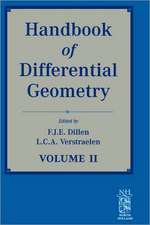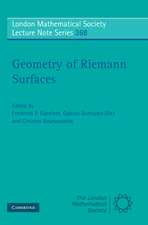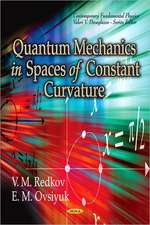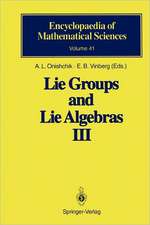A New Approach to Differential Geometry using Clifford's Geometric Algebra
Autor John Snyggen Limba Engleză Hardback – 8 dec 2011
Complete with chapter-by-chapter exercises, an overview of general relativity, and brief biographies of historical figures, this comprehensive textbook presents a valuable introduction to differential geometry. It will serve as a useful resource for upper-level undergraduates, beginning-level graduate students, and researchers in the algebra and physics communities.
Preț: 527.49 lei
Preț vechi: 635.53 lei
-17% Nou
Puncte Express: 791
Preț estimativ în valută:
100.94€ • 105.65$ • 84.01£
100.94€ • 105.65$ • 84.01£
Carte disponibilă
Livrare economică 10-24 martie
Livrare express 21-27 februarie pentru 45.26 lei
Preluare comenzi: 021 569.72.76
Specificații
ISBN-13: 9780817682828
ISBN-10: 0817682821
Pagini: 465
Ilustrații: XVII, 465 p. 102 illus.
Dimensiuni: 155 x 235 x 27 mm
Greutate: 0.85 kg
Ediția:2012
Editura: Birkhäuser Boston
Colecția Birkhäuser
Locul publicării:Boston, MA, United States
ISBN-10: 0817682821
Pagini: 465
Ilustrații: XVII, 465 p. 102 illus.
Dimensiuni: 155 x 235 x 27 mm
Greutate: 0.85 kg
Ediția:2012
Editura: Birkhäuser Boston
Colecția Birkhäuser
Locul publicării:Boston, MA, United States
Public țintă
Upper undergraduateCuprins
Preface.- Introduction.- Clifford Algebra in Euclidean 3-Space.- Clifford Algebra in Minkowski 4-Space.- Clifford Algebra in Flat n-Space.- Curved Spaces.- The Gauss-Bonnet Formula.- Non-Euclidean (Hyperbolic) Geometry.- Some Extrinsic Geometry in E^n.- Ruled Surfaces Continued.- Lines of Curvature.- Minimal Surfaces.- Some General Relativity.- Matrix Representation of a Clifford Algebra.- Construction of Coordinate Dirac Matrices.- A Few Terms of the Taylor's Series for the Urdī-Copernican Model for the Outer Planets.- A Few Terms of the Taylor's Series for Kepler's Orbits.- References.- Index.
Recenzii
From the reviews:
“The book is written in a very pedagogical style and seems to be the mirror of the original ideas of its author in the area of mathematical physics. … The typography is excellent and the figures are beautiful. … Graduate and advanced undergraduate students in physics and even in mathematics will find in this book an understanding of the contribution of Clifford algebras to the field of differential geometry as well as motivation to continue their study.” (Pierre Anglès, Mathematical Reviews, March, 2014)
“The book under review is perfectly organized textbook for undergraduate students in mathematics and physics due to the large experience of the author. … The author provides quite interesting historical analysis … . This book is a natural continuation of the previous book of the author … .” (Milen Hristov, JGSP Journal of Geometry and Symmetry in Physics, Vol. 33, 2014)
“The author develops the differential geometry of curves and surfaces by using Clifford’s geometric algebra. … The book is enriched with several very interesting and extensive historical and biographical presentations. … it can serve as an accompanying source for someone who studies differential geometry, or for someone who wants to look at known facts from a different viewpoint. Also, it is ideal for studying geometry through historical development, and thus this book could also be useful for reading courses on certain aspects of geometry.” (A. Arvanitoyeorgos, Zentralblatt MATH, Vol. 1232, 2012)
“The book is written in a very pedagogical style and seems to be the mirror of the original ideas of its author in the area of mathematical physics. … The typography is excellent and the figures are beautiful. … Graduate and advanced undergraduate students in physics and even in mathematics will find in this book an understanding of the contribution of Clifford algebras to the field of differential geometry as well as motivation to continue their study.” (Pierre Anglès, Mathematical Reviews, March, 2014)
“The book under review is perfectly organized textbook for undergraduate students in mathematics and physics due to the large experience of the author. … The author provides quite interesting historical analysis … . This book is a natural continuation of the previous book of the author … .” (Milen Hristov, JGSP Journal of Geometry and Symmetry in Physics, Vol. 33, 2014)
“The author develops the differential geometry of curves and surfaces by using Clifford’s geometric algebra. … The book is enriched with several very interesting and extensive historical and biographical presentations. … it can serve as an accompanying source for someone who studies differential geometry, or for someone who wants to look at known facts from a different viewpoint. Also, it is ideal for studying geometry through historical development, and thus this book could also be useful for reading courses on certain aspects of geometry.” (A. Arvanitoyeorgos, Zentralblatt MATH, Vol. 1232, 2012)
Textul de pe ultima copertă
Differential geometry is the study of curvature and calculus of curves and surfaces. Because of an historical accident, the Geometric Algebra devised by William Kingdom Clifford (1845–1879) has been overlooked in favor of the more complicated and less powerful formalism of differential forms and tangent vectors to deal with differential geometry. Fortuitously a student who has completed an undergraduate course in linear algebra is better prepared to deal with the intricacies of Clifford algebra than with the formalism currently used. Clifford algebra enables one to demonstrate a close relation between curvature and certain rotations. This is an advantage both conceptually and computationally—particularly in higher dimensions.
Key features and topics include:
* a unique undergraduate-level approach to differential geometry;
* brief biographies of historically relevant mathematicians and physicists;
* some aspects of special and general relativity accessible to undergraduates with no knowledge of Newtonian physics;
* chapter-by-chapter exercises.
The textbook will also serve as a useful classroom resource primarily for undergraduates as well as beginning-level graduate students; researchers in the algebra and physics communities may also find the book useful as a self-study guide.
Key features and topics include:
* a unique undergraduate-level approach to differential geometry;
* brief biographies of historically relevant mathematicians and physicists;
* some aspects of special and general relativity accessible to undergraduates with no knowledge of Newtonian physics;
* chapter-by-chapter exercises.
The textbook will also serve as a useful classroom resource primarily for undergraduates as well as beginning-level graduate students; researchers in the algebra and physics communities may also find the book useful as a self-study guide.
Caracteristici
Includes chapter-by-chapter exercises Provides a rare undergraduate-level approach to the subject matter Promotes the application of Clifford algebra to differential geometry Presents a significant portion of general relativity without reference to such Newtonian terms as "force", "momentum", or "energy" Only up-to-date title of its kind Includes supplementary material: sn.pub/extras




















